Burnup calculation of the OECD VVER-1000 LEU benchmark assembly using MCNP6 and SRAC2006
The present work aims to perform burnup calculation of the OECD VVER-1000 LEU (low
enriched uranium) computational benchmark assembly using the Monte Carlo code MCNP6 and the
deterministic code SRAC2006. The new depletion capability of MCNP6 was applied in the burnup
calculation of the VVER-1000 LEU benchmark assembly. The OTF (on-the-fly) methodology of
MCNP6, which involves high precision fitting of Doppler broadened cross sections over a wide
temperature range, was utilized to handle temperature variation for heavy isotopes. The collision
probability method based PIJ module of SRAC2006 was also used in this burnup calculation. The
reactivity of the fuel assembly, the isotopic concentrations and the shielding effect due to the presence
of the gadolinium isotopes were determined with burnup using MCNP6 and SRAC2006 in
comparison with the available published benchmark data. This study is therefore expected to reveal
the capabilities of MCNP6 and SRAC2006 in burnup calculation of VVER-1000 fuel assemblies.
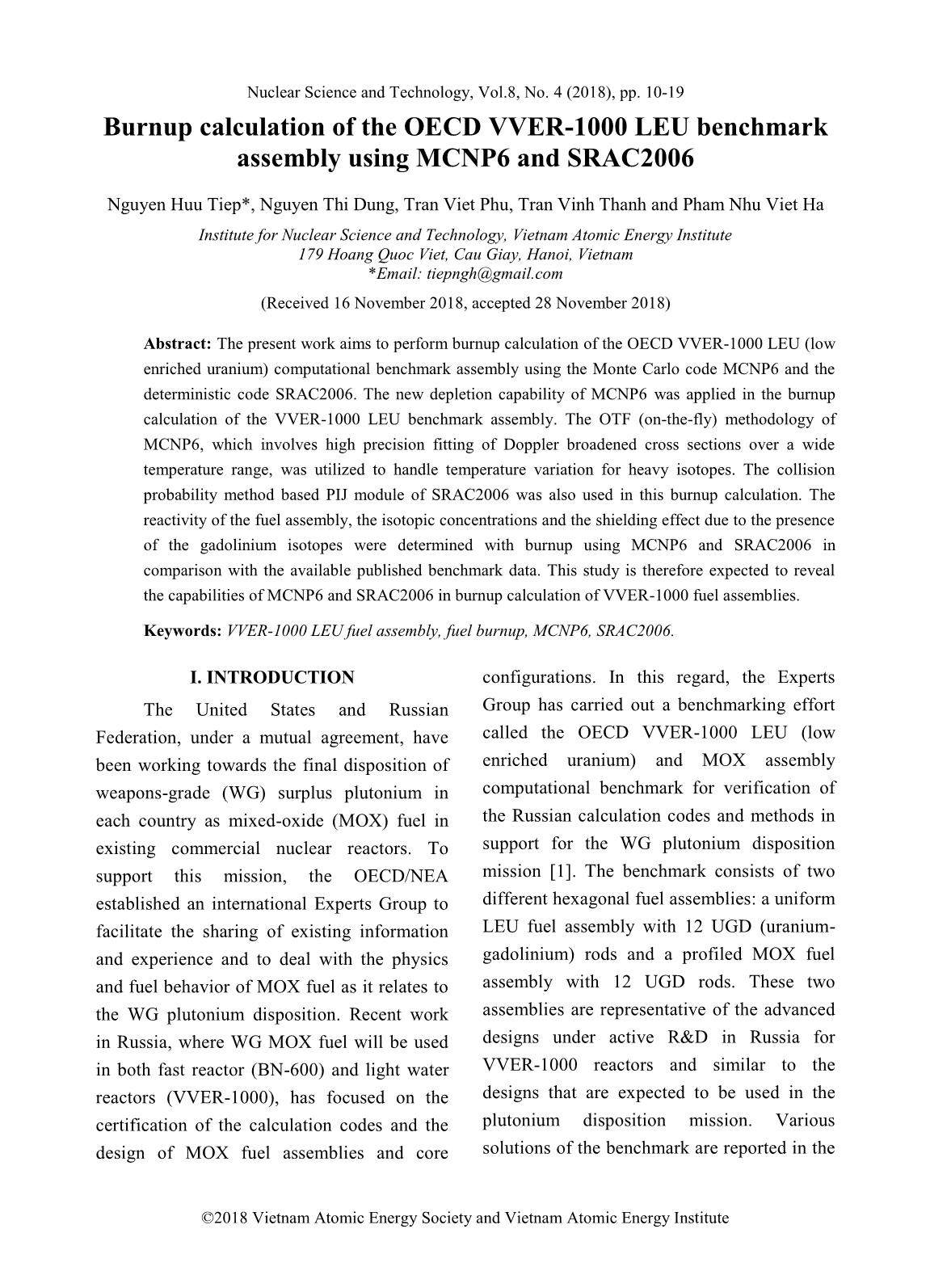
Trang 1
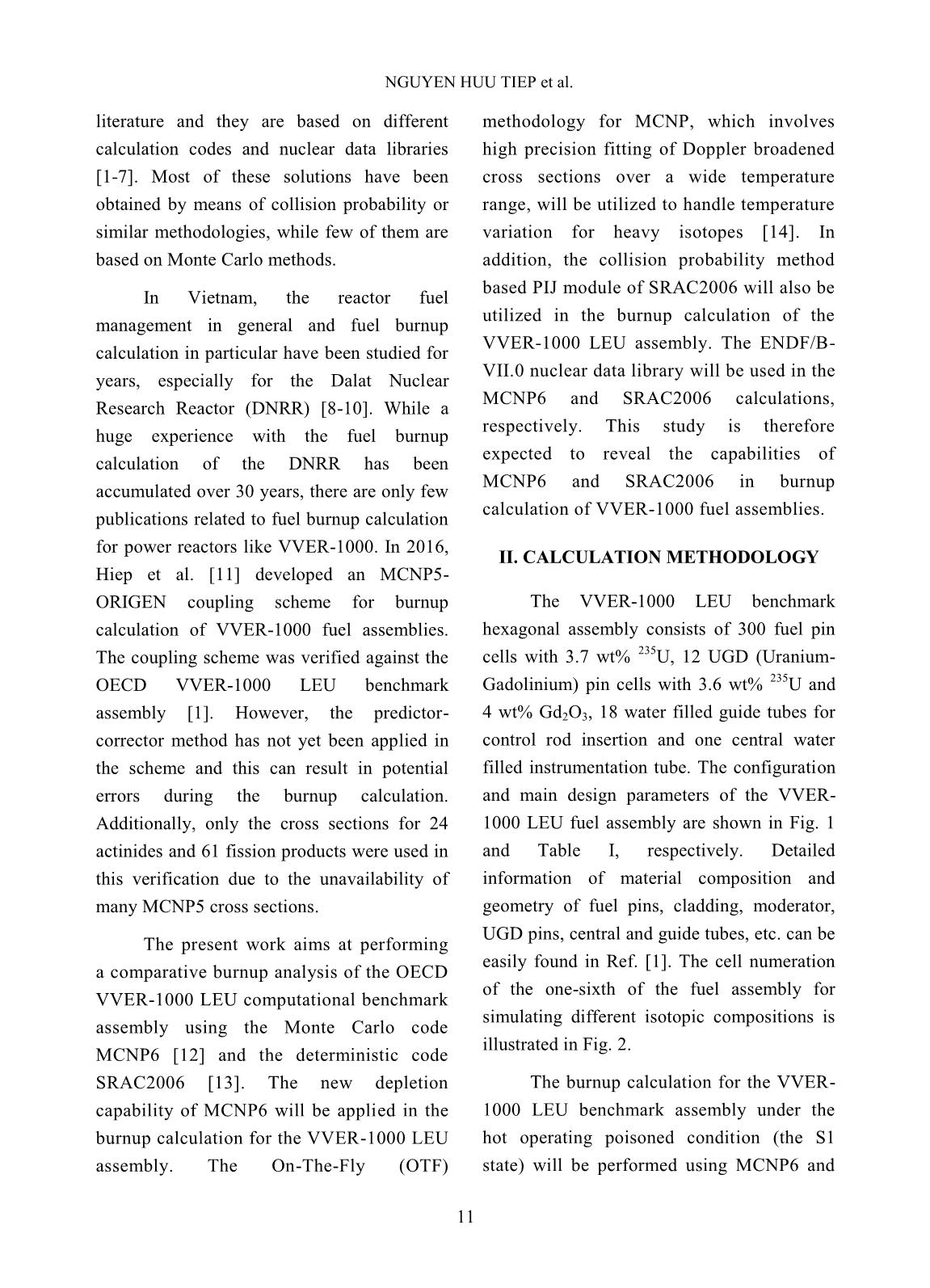
Trang 2
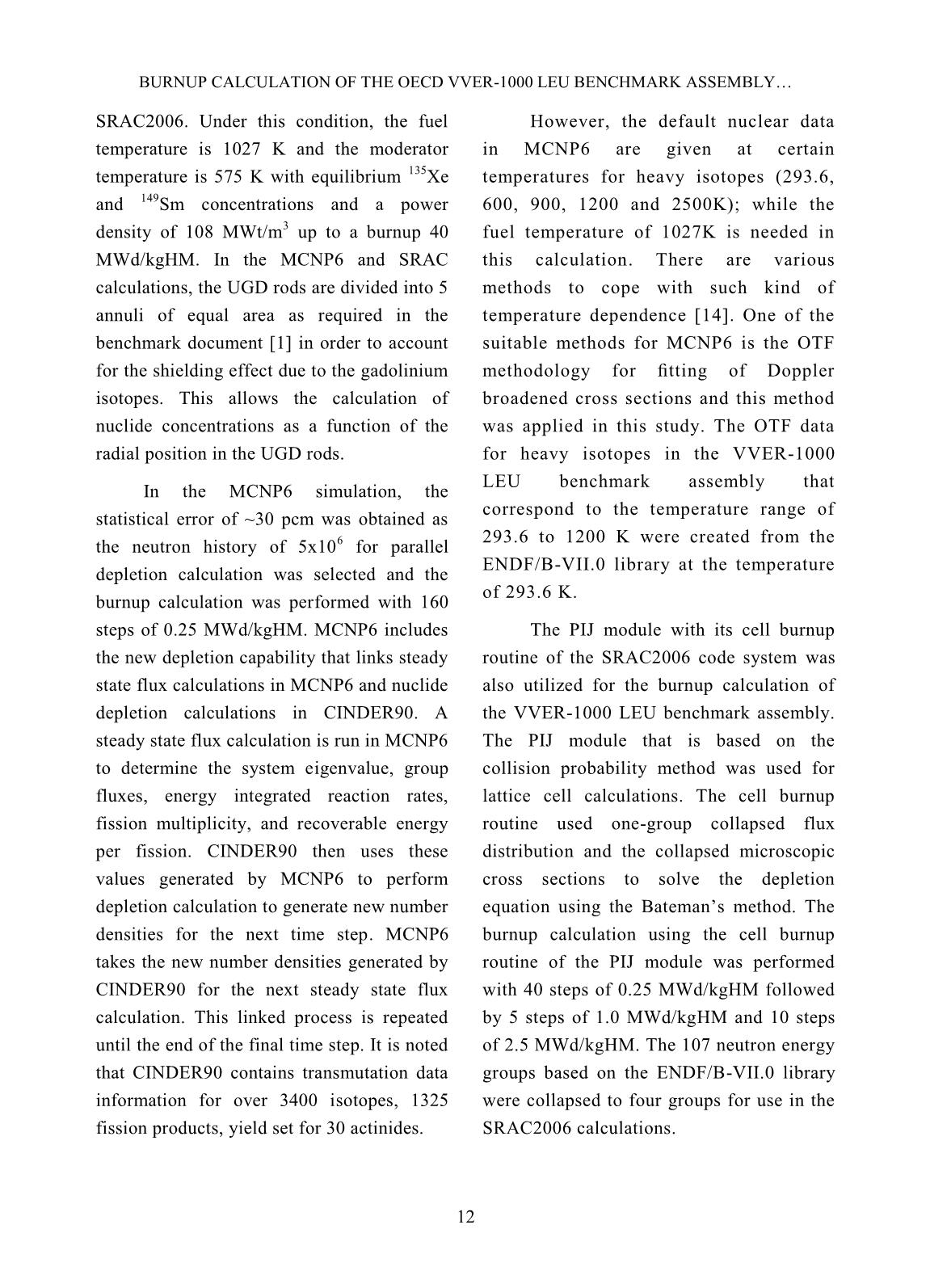
Trang 3
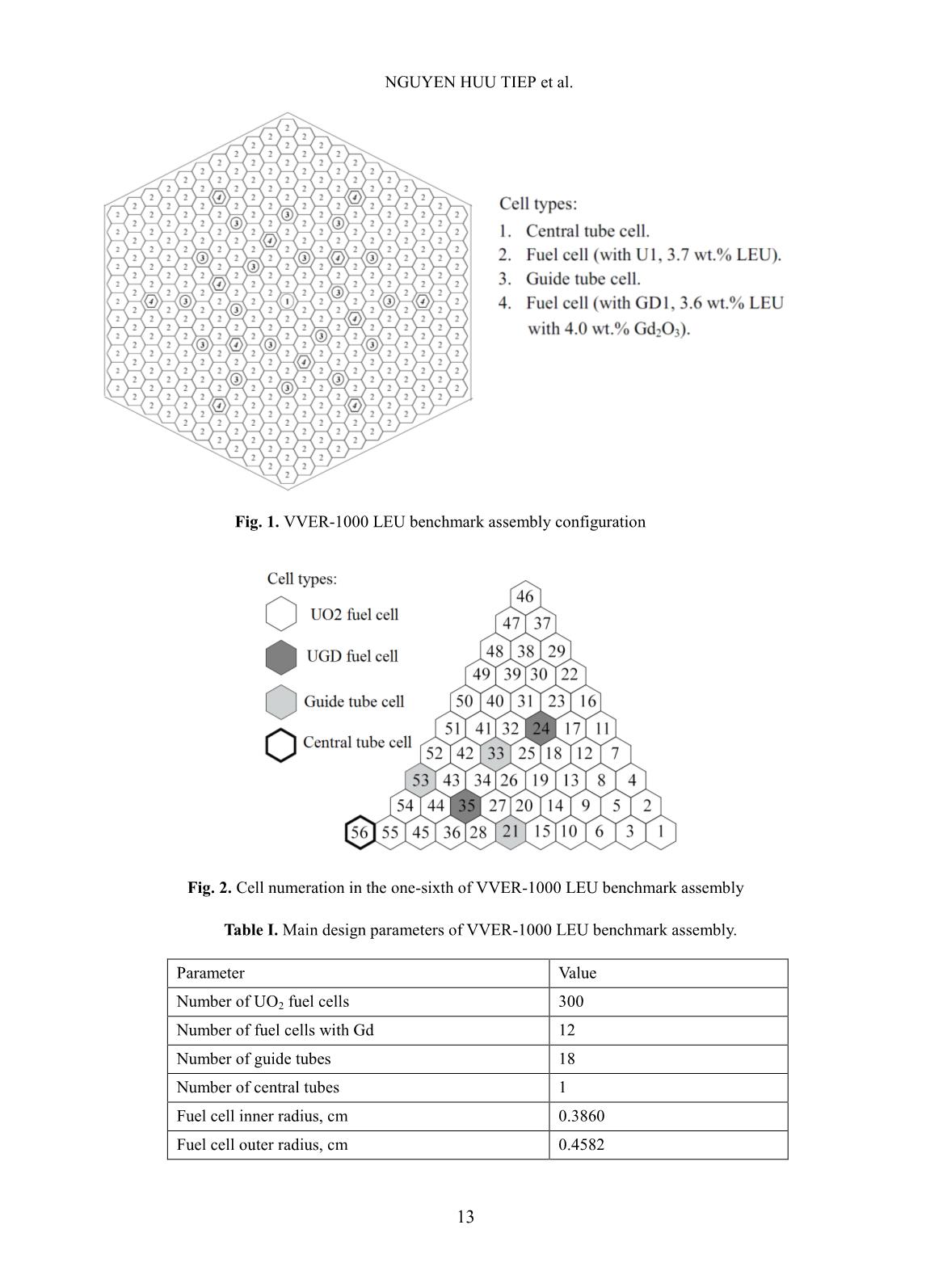
Trang 4
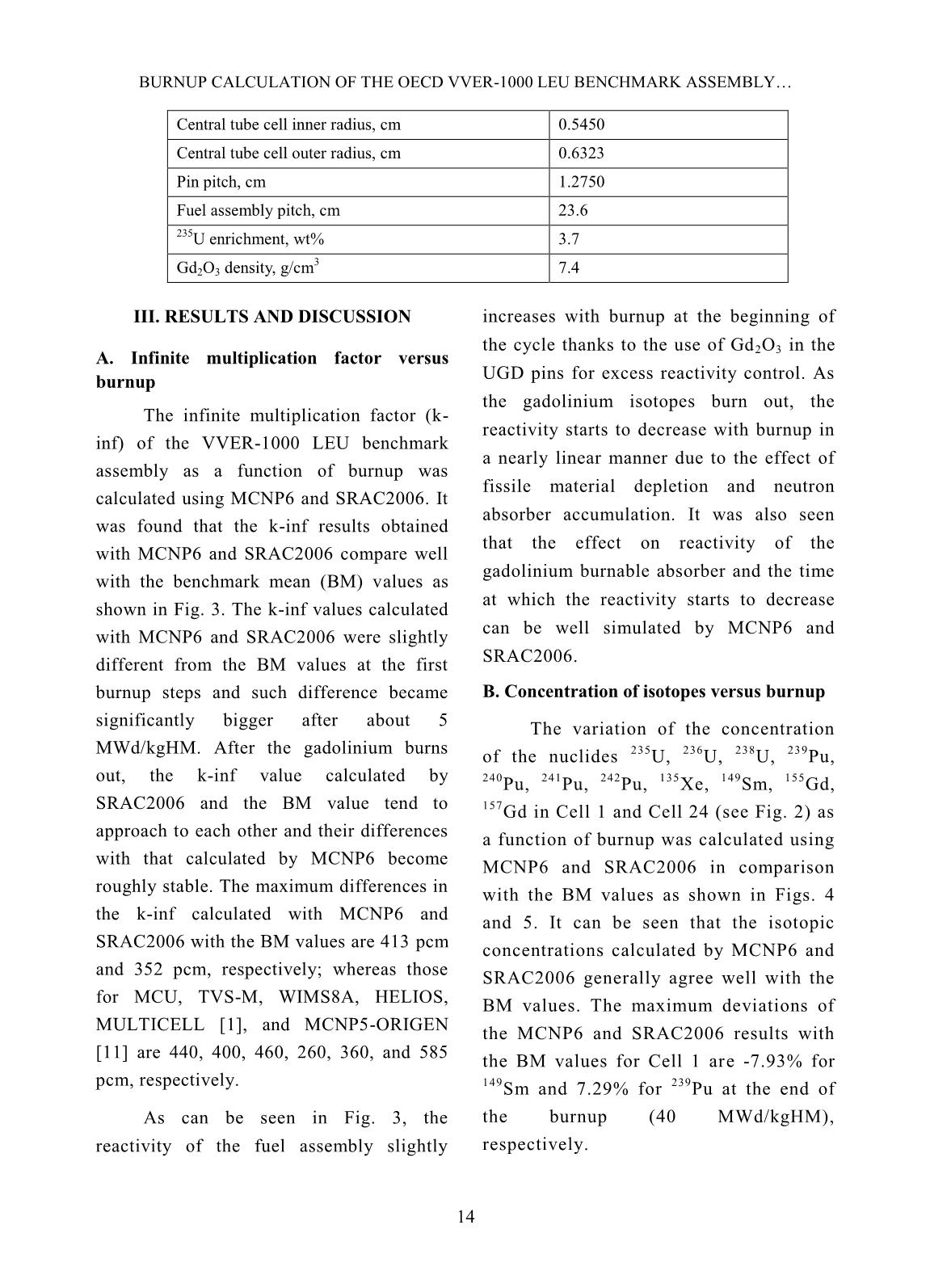
Trang 5
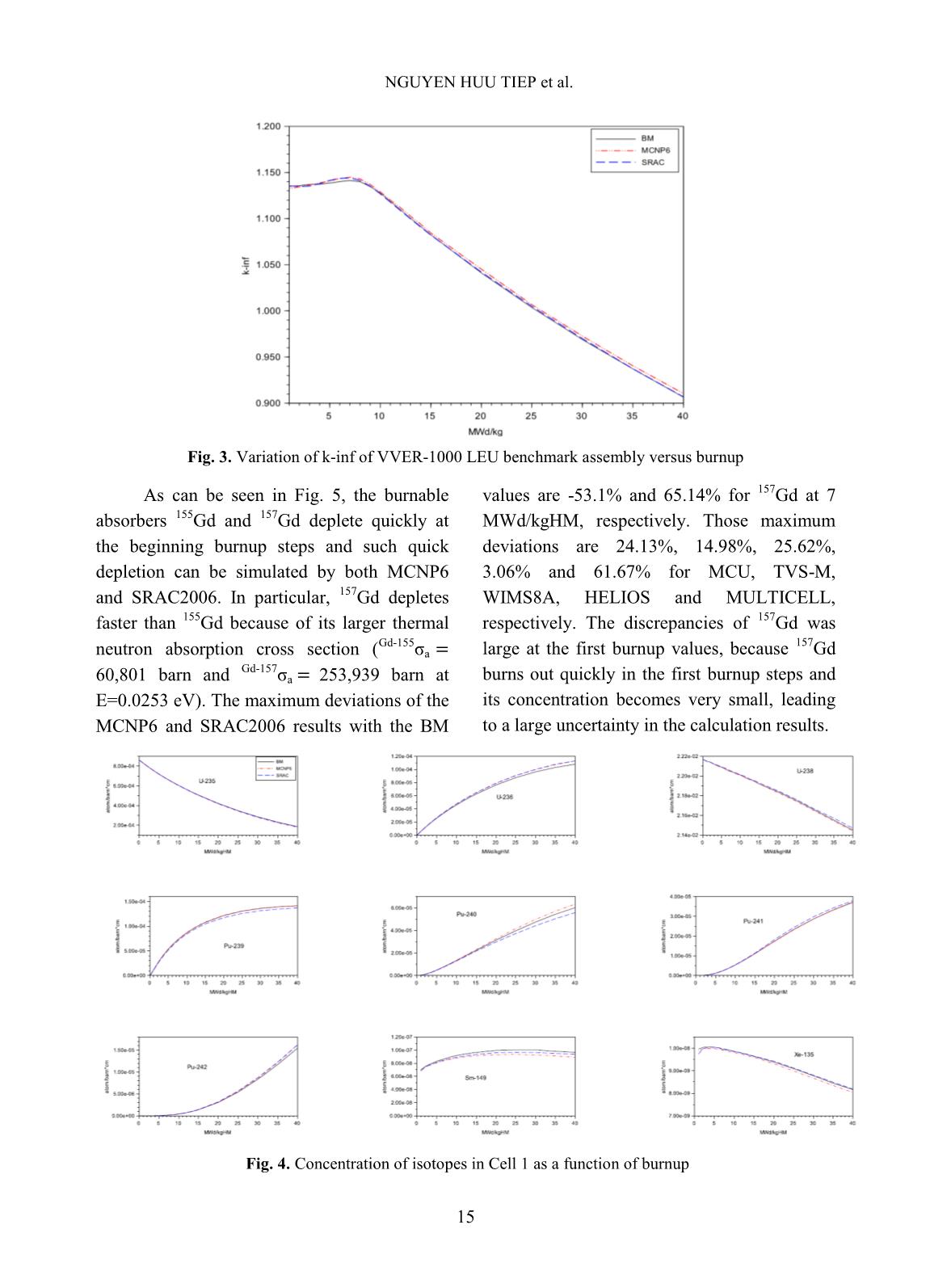
Trang 6
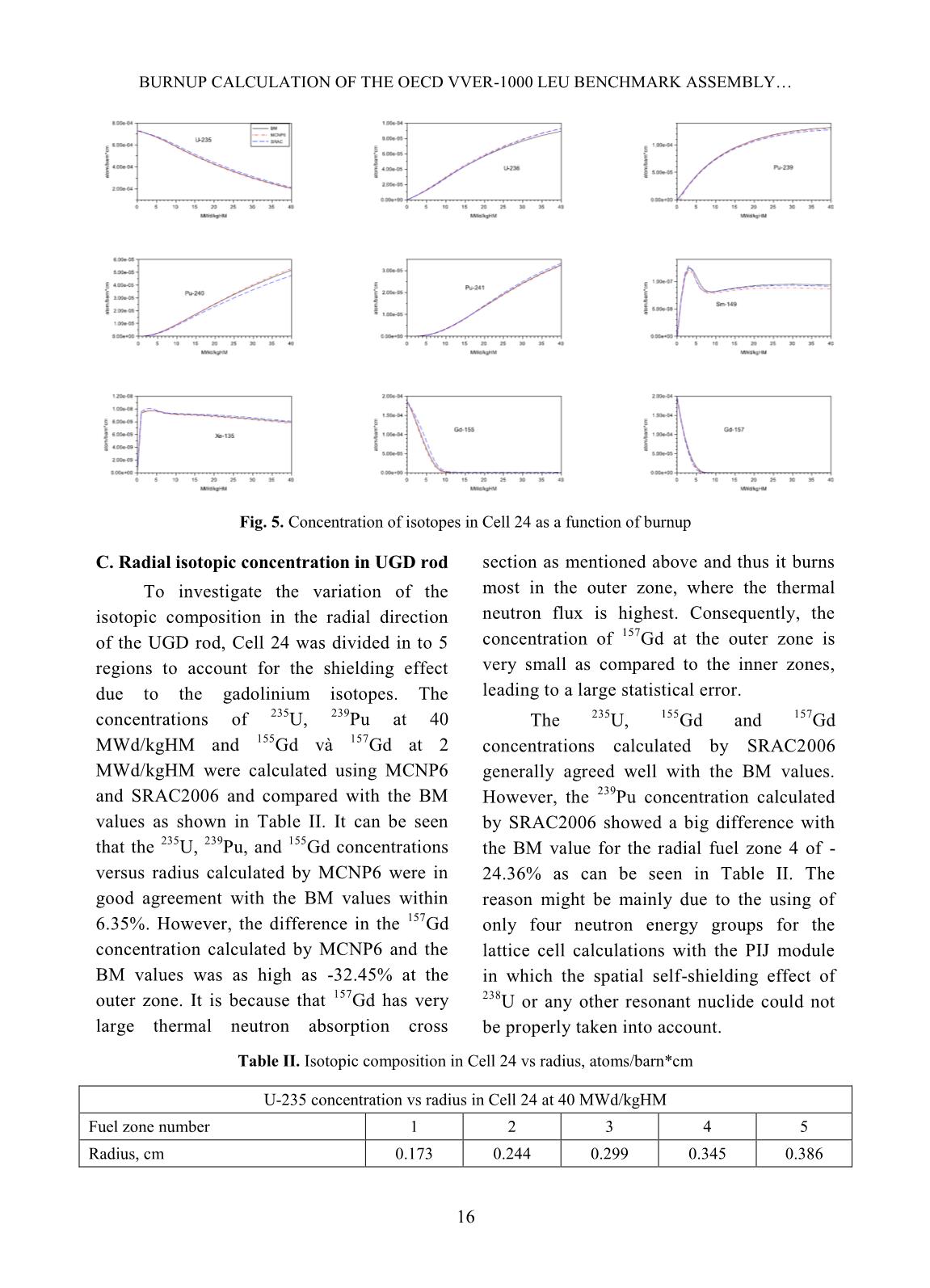
Trang 7
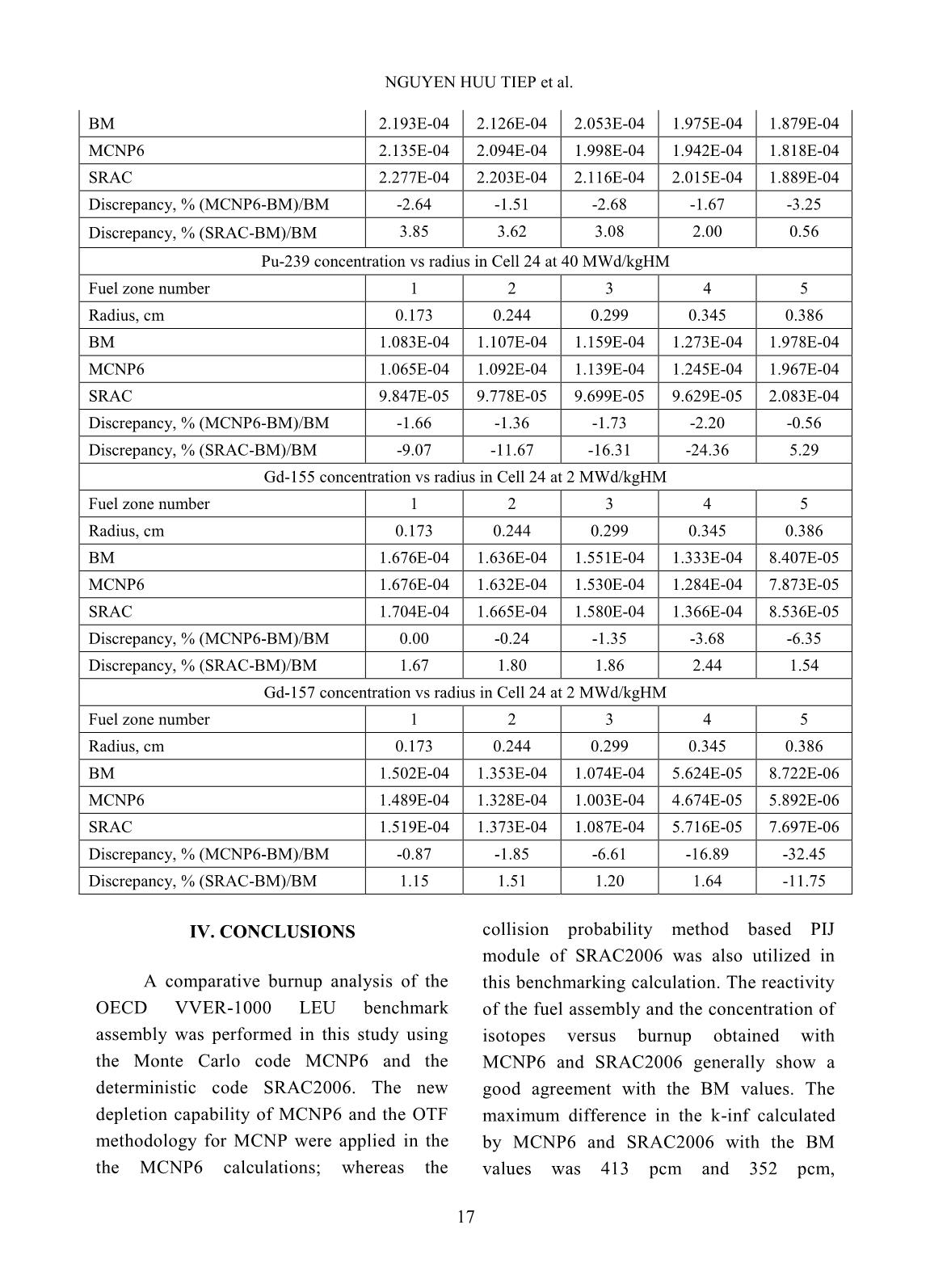
Trang 8
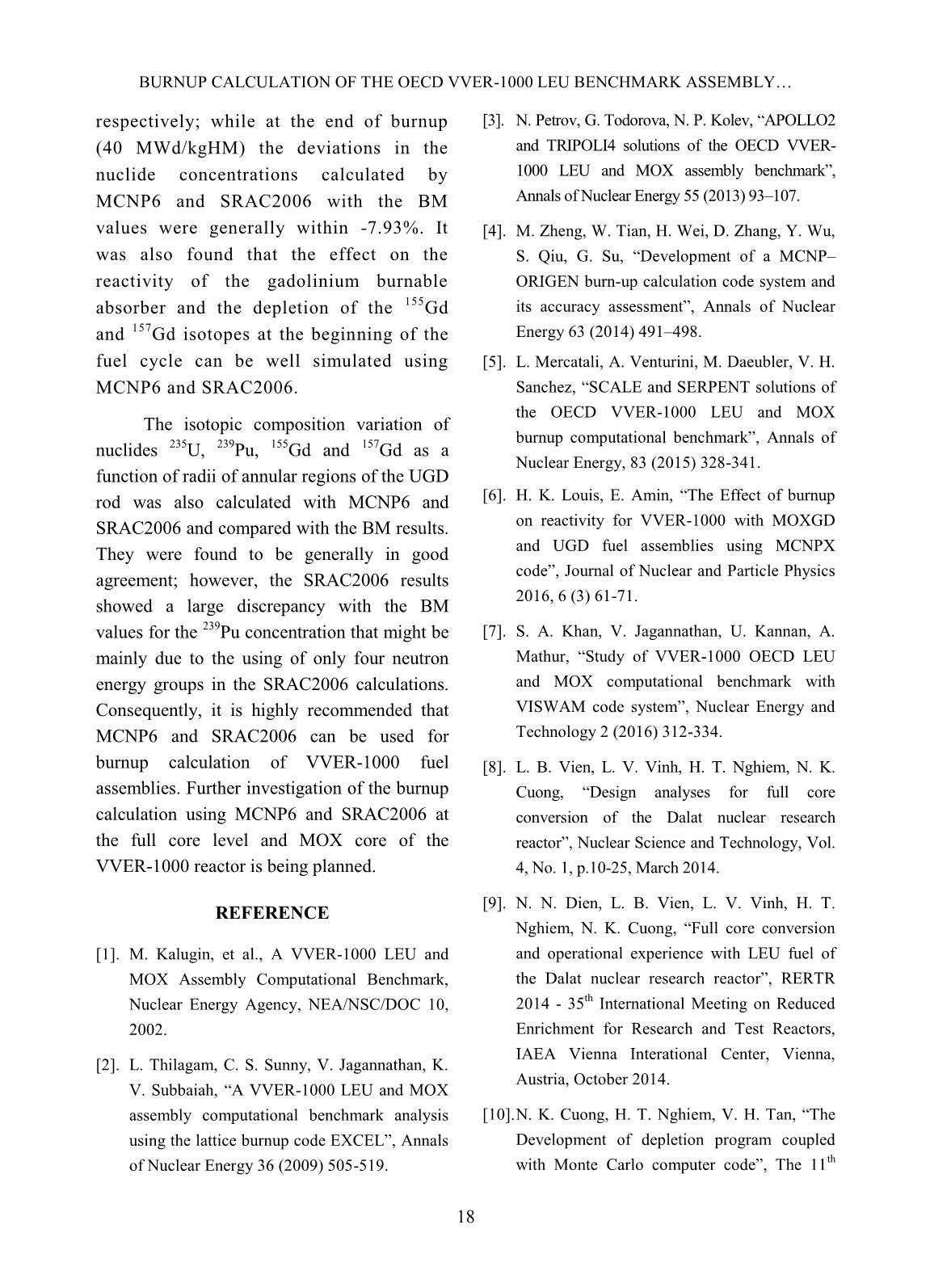
Trang 9

Trang 10
Tóm tắt nội dung tài liệu: Burnup calculation of the OECD VVER-1000 LEU benchmark assembly using MCNP6 and SRAC2006
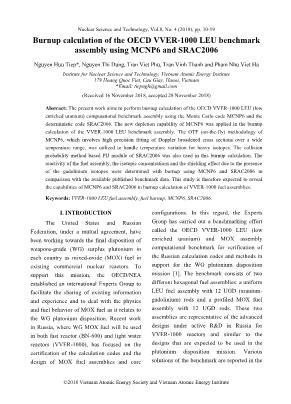
cludes the new depletion capability that links steady state flux calculations in MCNP6 and nuclide depletion calculations in CINDER90. A steady state flux calculation is run in MCNP6 to determine the system eigenvalue, group fluxes, energy integrated reaction rates, fission multiplicity, and recoverable energy per fission. CINDER90 then uses these values generated by MCNP6 to perform depletion calculation to generate new number densities for the next time step. MCNP6 takes the new number densities generated by CINDER90 for the next steady state flux calculation. This linked process is repeated until the end of the final time step. It is noted that CINDER90 contains transmutation data information for over 3400 isotopes, 1325 fission products, yield set for 30 actinides. However, the default nuclear data in MCNP6 are given at certain temperatures for heavy isotopes (293.6, 600, 900, 1200 and 2500K); while the fuel temperature of 1027K is needed in this calculation. There are various methods to cope with such kind of temperature dependence [14]. One of the suitable methods for MCNP6 is the OTF methodology for fitting of Doppler broadened cross sections and this method was applied in this study. The OTF data for heavy isotopes in the VVER-1000 LEU benchmark assembly that correspond to the temperature range of 293.6 to 1200 K were created from the ENDF/B-VII.0 library at the temperature of 293.6 K. The PIJ module with its cell burnup routine of the SRAC2006 code system was also utilized for the burnup calculation of the VVER-1000 LEU benchmark assembly. The PIJ module that is based on the collision probability method was used for lattice cell calculations. The cell burnup routine used one-group collapsed flux distribution and the collapsed microscopic cross sections to solve the depletion equation using the Bateman’s method. The burnup calculation using the cell burnup routine of the PIJ module was performed with 40 steps of 0.25 MWd/kgHM followed by 5 steps of 1.0 MWd/kgHM and 10 steps of 2.5 MWd/kgHM. The 107 neutron energy groups based on the ENDF/B-VII.0 library were collapsed to four groups for use in the SRAC2006 calculations. NGUYEN HUU TIEP et al. 13 Fig. 1. VVER-1000 LEU benchmark assembly configuration Fig. 2. Cell numeration in the one-sixth of VVER-1000 LEU benchmark assembly Table I. Main design parameters of VVER-1000 LEU benchmark assembly. Parameter Value Number of UO2 fuel cells 300 Number of fuel cells with Gd 12 Number of guide tubes 18 Number of central tubes 1 Fuel cell inner radius, cm 0.3860 Fuel cell outer radius, cm 0.4582 BURNUP CALCULATION OF THE OECD VVER-1000 LEU BENCHMARK ASSEMBLY 14 Central tube cell inner radius, cm 0.5450 Central tube cell outer radius, cm 0.6323 Pin pitch, cm 1.2750 Fuel assembly pitch, cm 23.6 235U enrichment, wt% 3.7 Gd2O3 density, g/cm 3 7.4 III. RESULTS AND DISCUSSION A. Infinite multiplication factor versus burnup The infinite multiplication factor (k- inf) of the VVER-1000 LEU benchmark assembly as a function of burnup was calculated using MCNP6 and SRAC2006. It was found that the k-inf results obtained with MCNP6 and SRAC2006 compare well with the benchmark mean (BM) values as shown in Fig. 3. The k-inf values calculated with MCNP6 and SRAC2006 were slightly different from the BM values at the first burnup steps and such difference became significantly bigger after about 5 MWd/kgHM. After the gadolinium burns out, the k-inf value calculated by SRAC2006 and the BM value tend to approach to each other and their differences with that calculated by MCNP6 become roughly stable. The maximum differences in the k-inf calculated with MCNP6 and SRAC2006 with the BM values are 413 pcm and 352 pcm, respectively; whereas those for MCU, TVS-M, WIMS8A, HELIOS, MULTICELL [1], and MCNP5-ORIGEN [11] are 440, 400, 460, 260, 360, and 585 pcm, respectively. As can be seen in Fig. 3, the reactivity of the fuel assembly slightly increases with burnup at the beginning of the cycle thanks to the use of Gd2O3 in the UGD pins for excess reactivity control. As the gadolinium isotopes burn out, the reactivity starts to decrease with burnup in a nearly linear manner due to the effect of fissile material depletion and neutron absorber accumulation. It was also seen that the effect on reactivity of the gadolinium burnable absorber and the time at which the reactivity starts to decrease can be well simulated by MCNP6 and SRAC2006. B. Concentration of isotopes versus burnup The variation of the concentration of the nuclides 235 U, 236 U, 238 U, 239 Pu, 240 Pu, 241 Pu, 242 Pu, 135 Xe, 149 Sm, 155 Gd, 157 Gd in Cell 1 and Cell 24 (see Fig. 2) as a function of burnup was calculated using MCNP6 and SRAC2006 in comparison with the BM values as shown in Figs. 4 and 5. It can be seen that the isotopic concentrations calculated by MCNP6 and SRAC2006 generally agree well with the BM values. The maximum deviations of the MCNP6 and SRAC2006 results with the BM values for Cell 1 are -7.93% for 149 Sm and 7.29% for 239 Pu at the end of the burnup (40 MWd/kgHM), respectively. NGUYEN HUU TIEP et al. 15 Fig. 3. Variation of k-inf of VVER-1000 LEU benchmark assembly versus burnup As can be seen in Fig. 5, the burnable absorbers 155 Gd and 157 Gd deplete quickly at the beginning burnup steps and such quick depletion can be simulated by both MCNP6 and SRAC2006. In particular, 157 Gd depletes faster than 155 Gd because of its larger thermal neutron absorption cross section ( Gd-155σa 60,801 barn and Gd-157σa 253,939 barn at E=0.0253 eV). The maximum deviations of the MCNP6 and SRAC2006 results with the BM values are -53.1% and 65.14% for 157 Gd at 7 MWd/kgHM, respectively. Those maximum deviations are 24.13%, 14.98%, 25.62%, 3.06% and 61.67% for MCU, TVS-M, WIMS8A, HELIOS and MULTICELL, respectively. The discrepancies of 157 Gd was large at the first burnup values, because 157 Gd burns out quickly in the first burnup steps and its concentration becomes very small, leading to a large uncertainty in the calculation results. Fig. 4. Concentration of isotopes in Cell 1 as a function of burnup BURNUP CALCULATION OF THE OECD VVER-1000 LEU BENCHMARK ASSEMBLY 16 Fig. 5. Concentration of isotopes in Cell 24 as a function of burnup C. Radial isotopic concentration in UGD rod To investigate the variation of the isotopic composition in the radial direction of the UGD rod, Cell 24 was divided in to 5 regions to account for the shielding effect due to the gadolinium isotopes. The concentrations of 235 U, 239 Pu at 40 MWd/kgHM and 155 Gd và 157 Gd at 2 MWd/kgHM were calculated using MCNP6 and SRAC2006 and compared with the BM values as shown in Table II. It can be seen that the 235 U, 239 Pu, and 155 Gd concentrations versus radius calculated by MCNP6 were in good agreement with the BM values within 6.35%. However, the difference in the 157 Gd concentration calculated by MCNP6 and the BM values was as high as -32.45% at the outer zone. It is because that 157 Gd has very large thermal neutron absorption cross section as mentioned above and thus it burns most in the outer zone, where the thermal neutron flux is highest. Consequently, the concentration of 157 Gd at the outer zone is very small as compared to the inner zones, leading to a large statistical error. The 235 U, 155 Gd and 157 Gd concentrations calculated by SRAC2006 generally agreed well with the BM values. However, the 239 Pu concentration calculated by SRAC2006 showed a big difference with the BM value for the radial fuel zone 4 of - 24.36% as can be seen in Table II. The reason might be mainly due to the using of only four neutron energy groups for the lattice cell calculations with the PIJ module in which the spatial self-shielding effect of 238 U or any other resonant nuclide could not be properly taken into account. Table II. Isotopic composition in Cell 24 vs radius, atoms/barn*cm U-235 concentration vs radius in Cell 24 at 40 MWd/kgHM Fuel zone number 1 2 3 4 5 Radius, cm 0.173 0.244 0.299 0.345 0.386 NGUYEN HUU TIEP et al. 17 BM 2.193E-04 2.126E-04 2.053E-04 1.975E-04 1.879E-04 MCNP6 2.135E-04 2.094E-04 1.998E-04 1.942E-04 1.818E-04 SRAC 2.277E-04 2.203E-04 2.116E-04 2.015E-04 1.889E-04 Discrepancy, % (MCNP6-BM)/BM -2.64 -1.51 -2.68 -1.67 -3.25 Discrepancy, % (SRAC-BM)/BM 3.85 3.62 3.08 2.00 0.56 Pu-239 concentration vs radius in Cell 24 at 40 MWd/kgHM Fuel zone number 1 2 3 4 5 Radius, cm 0.173 0.244 0.299 0.345 0.386 BM 1.083E-04 1.107E-04 1.159E-04 1.273E-04 1.978E-04 MCNP6 1.065E-04 1.092E-04 1.139E-04 1.245E-04 1.967E-04 SRAC 9.847E-05 9.778E-05 9.699E-05 9.629E-05 2.083E-04 Discrepancy, % (MCNP6-BM)/BM -1.66 -1.36 -1.73 -2.20 -0.56 Discrepancy, % (SRAC-BM)/BM -9.07 -11.67 -16.31 -24.36 5.29 Gd-155 concentration vs radius in Cell 24 at 2 MWd/kgHM Fuel zone number 1 2 3 4 5 Radius, cm 0.173 0.244 0.299 0.345 0.386 BM 1.676E-04 1.636E-04 1.551E-04 1.333E-04 8.407E-05 MCNP6 1.676E-04 1.632E-04 1.530E-04 1.284E-04 7.873E-05 SRAC 1.704E-04 1.665E-04 1.580E-04 1.366E-04 8.536E-05 Discrepancy, % (MCNP6-BM)/BM 0.00 -0.24 -1.35 -3.68 -6.35 Discrepancy, % (SRAC-BM)/BM 1.67 1.80 1.86 2.44 1.54 Gd-157 concentration vs radius in Cell 24 at 2 MWd/kgHM Fuel zone number 1 2 3 4 5 Radius, cm 0.173 0.244 0.299 0.345 0.386 BM 1.502E-04 1.353E-04 1.074E-04 5.624E-05 8.722E-06 MCNP6 1.489E-04 1.328E-04 1.003E-04 4.674E-05 5.892E-06 SRAC 1.519E-04 1.373E-04 1.087E-04 5.716E-05 7.697E-06 Discrepancy, % (MCNP6-BM)/BM -0.87 -1.85 -6.61 -16.89 -32.45 Discrepancy, % (SRAC-BM)/BM 1.15 1.51 1.20 1.64 -11.75 IV. CONCLUSIONS A comparative burnup analysis of the OECD VVER-1000 LEU benchmark assembly was performed in this study using the Monte Carlo code MCNP6 and the deterministic code SRAC2006. The new depletion capability of MCNP6 and the OTF methodology for MCNP were applied in the the MCNP6 calculations; whereas the collision probability method based PIJ module of SRAC2006 was also utilized in this benchmarking calculation. The reactivity of the fuel assembly and the concentration of isotopes versus burnup obtained with MCNP6 and SRAC2006 generally show a good agreement with the BM values. The maximum difference in the k-inf calculated by MCNP6 and SRAC2006 with the BM values was 413 pcm and 352 pcm, BURNUP CALCULATION OF THE OECD VVER-1000 LEU BENCHMARK ASSEMBLY 18 respectively; while at the end of burnup (40 MWd/kgHM) the deviations in the nuclide concentrations calculated by MCNP6 and SRAC2006 with the BM values were generally within -7.93%. It was also found that the effect on the reactivity of the gadolinium burnable absorber and the depletion of the 155 Gd and 157 Gd isotopes at the beginning of the fuel cycle can be well simulated using MCNP6 and SRAC2006. The isotopic composition variation of nuclides 235 U, 239 Pu, 155 Gd and 157 Gd as a function of radii of annular regions of the UGD rod was also calculated with MCNP6 and SRAC2006 and compared with the BM results. They were found to be generally in good agreement; however, the SRAC2006 results showed a large discrepancy with the BM values for the 239 Pu concentration that might be mainly due to the using of only four neutron energy groups in the SRAC2006 calculations. Consequently, it is highly recommended that MCNP6 and SRAC2006 can be used for burnup calculation of VVER-1000 fuel assemblies. Further investigation of the burnup calculation using MCNP6 and SRAC2006 at the full core level and MOX core of the VVER-1000 reactor is being planned. REFERENCE [1]. M. Kalugin, et al., A VVER-1000 LEU and MOX Assembly Computational Benchmark, Nuclear Energy Agency, NEA/NSC/DOC 10, 2002. [2]. L. Thilagam, C. S. Sunny, V. Jagannathan, K. V. Subbaiah, “A VVER-1000 LEU and MOX assembly computational benchmark analysis using the lattice burnup code EXCEL”, Annals of Nuclear Energy 36 (2009) 505-519. [3]. N. Petrov, G. Todorova, N. P. Kolev, “APOLLO2 and TRIPOLI4 solutions of the OECD VVER- 1000 LEU and MOX assembly benchmark”, Annals of Nuclear Energy 55 (2013) 93–107. [4]. M. Zheng, W. Tian, H. Wei, D. Zhang, Y. Wu, S. Qiu, G. Su, “Development of a MCNP– ORIGEN burn-up calculation code system and its accuracy assessment”, Annals of Nuclear Energy 63 (2014) 491–498. [5]. L. Mercatali, A. Venturini, M. Daeubler, V. H. Sanchez, “SCALE and SERPENT solutions of the OECD VVER-1000 LEU and MOX burnup computational benchmark”, Annals of Nuclear Energy, 83 (2015) 328-341. [6]. H. K. Louis, E. Amin, “The Effect of burnup on reactivity for VVER-1000 with MOXGD and UGD fuel assemblies using MCNPX code”, Journal of Nuclear and Particle Physics 2016, 6 (3) 61-71. [7]. S. A. Khan, V. Jagannathan, U. Kannan, A. Mathur, “Study of VVER-1000 OECD LEU and MOX computational benchmark with VISWAM code system”, Nuclear Energy and Technology 2 (2016) 312-334. [8]. L. B. Vien, L. V. Vinh, H. T. Nghiem, N. K. Cuong, “Design analyses for full core conversion of the Dalat nuclear research reactor”, Nuclear Science and Technology, Vol. 4, No. 1, p.10-25, March 2014. [9]. N. N. Dien, L. B. Vien, L. V. Vinh, H. T. Nghiem, N. K. Cuong, “Full core conversion and operational experience with LEU fuel of the Dalat nuclear research reactor”, RERTR 2014 - 35 th International Meeting on Reduced Enrichment for Research and Test Reactors, IAEA Vienna Interational Center, Vienna, Austria, October 2014. [10]. N. K. Cuong, H. T. Nghiem, V. H. Tan, “The Development of depletion program coupled with Monte Carlo computer code”, The 11th NGUYEN HUU TIEP et al. 19 National Conference on Nuclear Science and Technology, Da Nang,Vietnam, August 2015. [11]. N. H. Hiep, N. H. Tiep, T. V. Phu, N. T. Khai, “Development of an MCNP5-ORIGEN2 coupling scheme for burnup calculation of VVER-1000 fuel assemblies”, Nuclear Science and Technology, Vol. 6, No. 3 (2016), pp. 16-30. [12]. D. B. Pelowitz et al., MCNP6TM User’s Manual, Version 1.0, LA-CP-13-00634, Rev. 0, 2013. [13]. K. Okumura, T. Kugo, K. Kaneko, and K. Tsuchihashi, SRAC2006: A Comprehensive Neutronics Calculation Code System, JAEA- Data/Code 2007-004, 2007. [14]. F. Brown, W. Martin, G. Yesilyurt, S. Wilderman, On-The-Fly Neutron Doppler Broadening for MCNP, Los Alamos National Laboratory, LA-UR-12-00700, 2012.
File đính kèm:
 burnup_calculation_of_the_oecd_vver_1000_leu_benchmark_assem.pdf
burnup_calculation_of_the_oecd_vver_1000_leu_benchmark_assem.pdf

